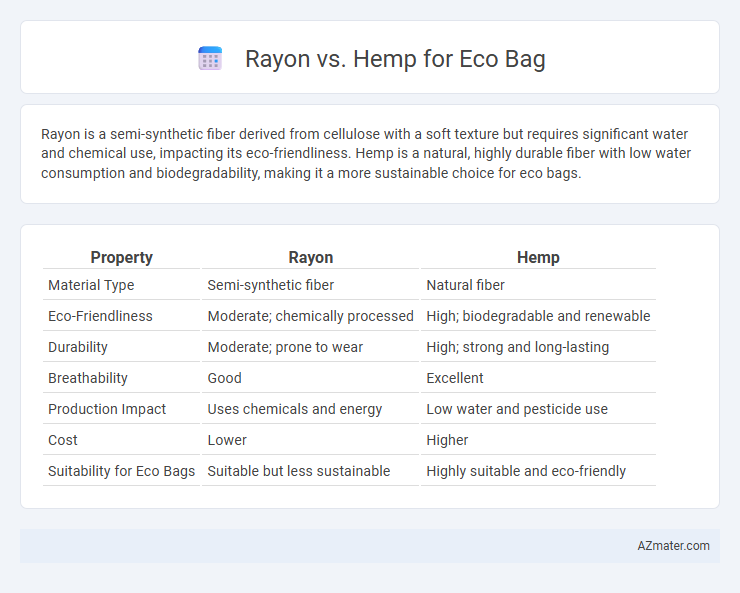Rayon is a semi-synthetic fiber derived from cellulose with a soft texture but requires significant water and chemical use, impacting its eco-friendliness. Hemp is a natural, highly durable fiber with low water consumption and biodegradability, making it a more sustainable choice for eco bags.
Table of Comparison
| Property | Rayon | Hemp |
|---|---|---|
| Material Type | Semi-synthetic fiber | Natural fiber |
| Eco-Friendliness | Moderate; chemically processed | High; biodegradable and renewable |
| Durability | Moderate; prone to wear | High; strong and long-lasting |
| Breathability | Good | Excellent |
| Production Impact | Uses chemicals and energy | Low water and pesticide use |
| Cost | Lower | Higher |
| Suitability for Eco Bags | Suitable but less sustainable | Highly suitable and eco-friendly |
Introduction to Eco Bags: Why Material Matters
Eco bags crafted from hemp offer superior durability and biodegradability compared to rayon, which is chemically processed from wood pulp and less eco-friendly. Hemp's natural resistance to wear and pests makes it ideal for sustainable bags that reduce environmental impact over time. Choosing hemp over rayon supports eco-conscious consumers seeking long-lasting, biodegradable alternatives to synthetic or semi-synthetic materials.
Overview of Rayon and Hemp Fibers
Rayon fibers are semi-synthetic, derived from regenerated cellulose, offering smooth texture and high absorbency, making them suitable for eco bags with a soft touch and vibrant dye acceptance. Hemp fibers, obtained from the stalks of the Cannabis sativa plant, are natural, coarse, and highly durable, providing superior strength, mold resistance, and biodegradability for sustainable and long-lasting eco bags. Both fibers contribute to eco-friendly bag production, with rayon emphasizing comfort and appearance, while hemp prioritizes environmental sustainability and robustness.
Environmental Impact: Rayon vs Hemp
Hemp bags offer a significantly lower environmental impact compared to rayon bags due to hemp's natural biodegradability, minimal pesticide requirement, and its ability to improve soil health. Rayon production involves heavy chemical processing, including toxic solvents like carbon disulfide, which contribute to water pollution and increased carbon emissions. Choosing hemp for eco bags supports sustainable agriculture and reduces ecological damage associated with synthetic fiber manufacturing.
Biodegradability and Sustainability Compared
Hemp fibers offer superior biodegradability compared to rayon, breaking down naturally without releasing harmful chemicals, which enhances its sustainability profile. Rayon, derived from cellulose but subjected to intensive chemical processing, tends to be less eco-friendly due to its energy-intensive production and less efficient biodegradation. Choosing hemp for eco bags supports sustainable agriculture with low water use and maintained soil health, making it a more environmentally responsible option.
Production Processes: How Rayon and Hemp are Made
Rayon is produced through a chemical-intensive process involving the treatment of cellulose from wood pulp with strong solvents like sodium hydroxide and carbon disulfide, followed by regeneration into fibers. Hemp production involves mechanical processing of the stalks to separate the outer fibers, which are then cleaned, combed, and spun with minimal chemical intervention, making it a more sustainable choice. The energy consumption and chemical use in rayon manufacturing often result in higher environmental impacts compared to the eco-friendly, low-impact processing of hemp fibers.
Durability and Strength of Eco Bags
Hemp fibers are significantly stronger and more durable than rayon, making hemp eco bags more resistant to wear and tear over time, especially under heavy loads. Rayon, derived from cellulose fibers, tends to be softer but less resilient, often showing signs of fraying and weakening after repeated use. Choosing hemp for eco bags ensures longevity and robust performance, ideal for sustainable and reliable everyday carrying needs.
Style and Texture: Look and Feel Differences
Rayon offers a smooth, silky texture with a slight sheen that gives eco bags a sophisticated, lightweight appearance, while hemp provides a coarse, rugged feel that conveys durability and natural, earthy aesthetics. Eco bags made from rayon tend to drape elegantly with a soft touch, suitable for urban, fashion-forward styles, whereas hemp bags boast a sturdy, structured form with a matte finish, ideal for rustic or artisanal looks. The distinct tactile qualities of rayon and hemp influence the visual impression and user experience, making hemp preferable for eco-conscious consumers valuing texture and resilience.
Cost and Market Availability
Rayon is generally more affordable than hemp, making it a popular choice for cost-sensitive eco bag manufacturers. Hemp, valued for its durability and sustainability, tends to be pricier due to more intensive cultivation and processing methods. Market availability of rayon is higher globally because it is mass-produced from wood pulp, whereas hemp's availability is limited by regional agricultural regulations and slower production cycles.
Consumer Health and Safety Considerations
Rayon, a semi-synthetic fiber derived from cellulose, often undergoes chemical processing that may leave residues potentially irritating to sensitive skin, raising consumer health concerns for eco bag usage. Hemp, a natural fiber, offers superior breathability, durability, and is grown without harmful pesticides, making it a safer and more hypoallergenic choice for consumers prioritizing health and safety. Choosing hemp eco bags supports reduced chemical exposure and promotes long-term skin compatibility compared to chemically-intensive rayon bags.
Conclusion: Choosing the Right Material for Eco Bags
Hemp offers superior durability, biodegradability, and minimal environmental impact compared to rayon, which often involves chemical-intensive processing and lower sustainability. Eco bags made from hemp provide long-lasting, strong, and eco-friendly alternatives ideal for reducing plastic waste. Selecting hemp as the primary material ensures a greener choice aligned with sustainable fashion and environmental responsibility goals.

Infographic: Rayon vs Hemp for Eco Bag
 azmater.com
azmater.com